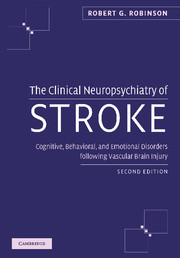 The Clinical Neuropsychiatry of Stroke
The Clinical Neuropsychiatry of Stroke Book contents
- Frontmatter
- Contents
- Preface
- Part I Introduction
- Part II Poststroke depression
- Part III Poststroke mania
- Part IV Poststroke anxiety disorders
- 29 Prevalence and specificity of clinical symptoms
- 30 Clinical and lesion correlates
- 31 Longitudinal course
- 32 Relationship of anxiety to outcome
- 33 Mechanism and treatment of poststroke anxiety disorder
- Part V Other poststroke disorders
- Index
30 - Clinical and lesion correlates
from Part IV - Poststroke anxiety disorders
Published online by Cambridge University Press: 01 October 2009
- Frontmatter
- Contents
- Preface
- Part I Introduction
- Part II Poststroke depression
- Part III Poststroke mania
- Part IV Poststroke anxiety disorders
- 29 Prevalence and specificity of clinical symptoms
- 30 Clinical and lesion correlates
- 31 Longitudinal course
- 32 Relationship of anxiety to outcome
- 33 Mechanism and treatment of poststroke anxiety disorder
- Part V Other poststroke disorders
- Index
Summary
In the previous chapter, “Prevalence and specificity of clinical symptoms,” I listed a number of investigators in Table 29.1 who have examined the clinical and lesion correlates of anxiety disorder following stroke. In an effort to reexamine our findings on the clinical and pathological correlates of poststroke anxiety disorder, we recently analyzed data from our largest group of patients which included 396 acute stroke patients. The background characteristics of patients with or without generalized anxiety disorder (GAD), as defined by DSM-IV symptom criteria, are shown in Table 30.1. Patients were also grouped according to the presence or absence of major depression. More than half of the patients with DSM-IV-defined GAD also had associated major depression. There were significant intergroup differences in background characteristics including age, previous personal history of psychiatric disorder, and previous personal history of alcohol abuse. Two-way analysis of variance (ANOVA) examining the effects of depression (Factor 1) and GAD (Factor 2) demonstrated that GAD was associated with younger age (p = 0.01) and having a history of alcohol abuse (p = 0.01) while having a previous personal history of psychiatric disorder was associated with depression (p = 0.01).
The results of assessment of depression, activities of daily living, cognitive function, and social function are shown in Table 30.2.
- Type
- Chapter
- Information
- The Clinical Neuropsychiatry of StrokeCognitive, Behavioral and Emotional Disorders following Vascular Brain Injury, pp. 326 - 333Publisher: Cambridge University PressPrint publication year: 2006
- 4
- Cited by


